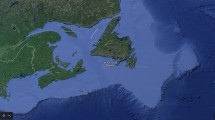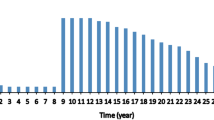Abstract
Well construction costs comprise the largest component of the capital expenditures required in onshore development, but detailed cost studies at a play level based on actual cost has never been presented in the literature. The purpose of this paper is to evaluate well construction cost in the Louisiana Haynesville shale from 2007 to 2012 and present cost statistics and correlations at a regional and operator level. Over half of the wells constructed in Louisiana’s Haynesville shale since its discovery cost between $8 and $11 million to drill and complete, and the average well cost is $9.95 million. EP Energy LLC realized the lowest average drilling and completion cost at $8.4 million per well, and the highest average cost among leading operators was Swepi LP at $11.1 million per well. We conclude with an empirical analysis of learning effects.



























Similar content being viewed by others
Notes
Conversion factors from English to SI units are given in Appendix 1.
Long-radius horizontal wells have build rates in the 3 deg/100 ft range with the horizontal part of the borehole several thousand feet in length. Medium-radius horizontal wells have build rates 30 deg/100 ft and are usually drilled for shallow objectives.
Upgrades may involve converting a rig from mechanical to electric power, expanding mud pump capacity, and adding drawworks horsepower. Upgrades may be performed at any time and is an investment decision.
A unit is an area of land or minerals where the owners of the minerals share in the costs and revenues of drilling and completion (La. Mineral Code art. 213(6)(2009)). If an operator cannot get all of the owners to agree to “pool” their interest, the Louisiana Commission of Conservation may force pooling of minerals creating a “compulsory unit” to prevent waste or to avoid drilling unnecessary wells (La. Rev. Stat. Ann. 30:10(A)(i)(2009)).
The best-fit model parameters for the functional specification Cost = A + B * MD all yield R 2 > 0.90, but because A < 0 for most years, we favored eliminating the fixed cost component in the relations.
References
API. (2008). Joint Association Survey on drilling costs. Washington, DC: American Petroleum Institute.
Billa, R., Mota, J., Schneider, B., & Weissman, M. (2011). Drilling performance improvement in the Haynesville shale play. Paper presented at the SPE/IADC Drilling Conference and Exhibition, Amsterdam, Netherlands, 1–3 March 2011. SPE/IADC 139842.
Bourgoyne, A. T., Millheim, K. K., Chenevert, M. E., & Young, F. S. (2003). Applied drilling engineering. Richardson, TX: Society of Petroleum Engineers.
Chesapeake Energy Corporation. 2010. Chesapeake Energy 2010 annual report. http://www.chk.com/Media/Publications/AnnualReport/Documents/PDF/2010AnnualReport.pdf.
Cipolla, C. L., Warpinski, N., Mayerhofer, M. J., & Lolon, E. P. (2008). The relationship between fracture complexity, reservoir properties, and fracture treatment design. Paper presented at the Annual Technical Conference and Exhibition, Denver, CO, 21–24 September 2008. SPE 115769.
EnCana Company. 2010. EnCana 2010 annual report. http://www.encana.com/investors/financial/annualreports/2010/pdfs/annual-report-2010.pdf.
Giles, M. R., Nevin, D., Johnston, B., & Hollanders, M. (2012). Understanding volumes, economics and risk mitigation in unconventional gas projects. Paper presented at the SPE/EAGE European Unconventional Resources Conference and Exhibition, Vienna, Austria, 20–22 March 2012. SPE 151906.
Guo, Q., Ji, L., Rajabov, V., Fridheim, J., & Wu, R. (2012). Marcellus and Haynesville drilling data: Analysis and lessons learned. Paper presented at the SPE Asia Pacific Oil and Gas Conference and Exhibition, Perth, Australia, 22–24 October 2012. SPE 158894.
Hammes, U., & Frébourg, G. (2012). Haynesville and Bossier mudrocks: A facies and sequence stratigraphic investigation, East Texas and Louisiana, USA. Marine and Petroleum Geology, 31, 8–26.
Hammes, U., Hamlin, H. S., & Ewing, T. E. (2011). Geologic analysis of the Upper Jurassic Haynesville Shale in east Texas and west Louisiana. AAPG Bulletin, 95(10), 1643–1666.
Jenkins, P. B., & Crockford, A. L. (1975). Drilling costs. Paper presented at the SPE-European Meeting, London, England, April 1975. SPE 5266.
Joshi, S. D. (2003). Cost/benefits of horizontal wells. Paper presented at the SPE Western Regional/AAPG Pacific Section Meeting, Long Beach, CA, 19–24 May 2003. SPE 83621.
Kaiser, M. J. (2007). A survey of drilling cost and complexity estimation models. International Journal of Petroleum Science and Technology, 1(1), 1–22.
Kaiser, M. J. (2012). Economic analysis of Haynesville shale gas wells. Journal of Petroleum Science and Engineering, 82(83), 75–89.
Kaiser, M. J., & Pulsipher, A. G. (2007). Generalized functional models for drilling cost and complexity estimation. SPE Journal of Drilling and Completion, 22, 67–73.
Kaiser, M. J., & Yu, Y. (2011). Haynesville shale gas well performance and development potential. Natural Resources Research, 20(4), 217–229.
Louisiana Department of Natural Resources. (2013). SONRIS. Retrieved January 15, 2013, from http://sonris.com/.
Martin, A. N., & Economides, M. J. (2010). Best practices for candidate selection, design and evaluation of hydraulic fracture treatments. Paper presented at the SPE Production and Operations Conference and Exhibition, Tunis, Tunisia, 8–10 June 2010. SPE 135669.
Modeland, N., Buller, D., & Chong, K. (2011). Statistical analysis of the effect of completion methodology on production in the Haynesville shale. Paper presented at the North American Unconventional Gas Conference and Exhibition, The Woodlands, TX, 14–16 June 2011. SPE 144120.
Montilva, J., Mota, J., & Billa, R. (2012b). Onshore US MPD use by an operator. Paper presented at the SPE/IADC Managed Pressure Drilling and Underbalanced Operations Conference and Exhibition, Milan, Italy, 20–21 March 2012. SPE 156909.
Montilva, J., Mota, J., Poletzky, I. C., Sati, M., Lovorn, R., & Grable, J. (2012a). Next-generation managed pressure drilling system enables HP/HT horizontal wells in the Haynesville shale. Paper presented at the IADC/SPE Drilling Conference and Exhibition, San Diego, CA, 6–8 March 2012. IADC/SPE 151168.
Osmundsen, P., Roll, K., & Tveteras, R. (2010). Exploration drilling productivity at the Norwegian shelf. Journal of Petroleum Science and Engineering, 71(73), 122–128.
Osmundsen, P., Roll, K., & Tveteras, R. (2012). Drilling speed—The relevance of experience. Energy Economics, 34, 786–794.
Peterson, S. K., Murtha, J. A. J., & Schneider, F. F. (1993). Risk analysis and Monte Carlo simulation applied to the generation of drilling AFE estimates. Paper presented at the SPE Annual Technical Conference and Exhibition, Houston, TX, 3–6 October 1993. SPE 26339.
Pope, C., Peters, B., Benton, T., & Palisch, T. (2009). Haynesville shale—One operator’s approach to well completions in this evolving play. Paper presented at the SPE Annual Technical Conference and Exhibition, New Orleans, Louisiana, 4–7 October 2009. SPE 125079.
Thompson, J. W., Fan, L., Grant, D., Martin, R. B., Kanneganti, K. T., & Lindsay, G. J. (2010). An overview of horizontal well completions in the Haynesville shale. Paper presented at the Canadian Unconventional Resources & International Petroleum Conference, Calgary, AB, Canada, 19–21 October 2010. CSUG/SPE 136875.
Ursem L. J., Williams J. H., Pellerin N. M., & Kaminksi, D. H. (2003). The people aspects of drilling decision making. Paper presented at the SPE/IADC Drilling Conference, Amsterdam, The Netherlands, 19–21 February 2003. SPE/IADC 13245.
Van Oort, E., Griffith, J., & Schneider, B. (2011). How to accelerate drilling learning curves. Paper presented at the SPE/IADC Drilling Conference and Exhibition, Amsterdam, Netherlands, 1–3 March 2011. SPE/IADC 140333.
Wutherich, K. D., & Walker, K. J. (2012). Designing completions in horizontal shale gas wells—perforation strategies. Paper presented at the Americas Unconventional Resources Conference, Pittsburg, PA, 5–7 June 2012. SPE 155485.
Author information
Authors and Affiliations
Corresponding author
Appendices
Appendix 1: Conversion Factors
Appendix 2: Louisiana Severance Tax Relief Program
Severance Tax Exemption
Louisiana provides a severance tax exemption on all horizontal wells drilled or recompleted where production commenced after July 31, 1994. Under Louisiana Revised Statute 47:633(7)(c), all severance tax on a horizontal well is suspended for a period of 24 months or until payout of drilling and completion cost is achieved, whichever comes first. Applicants for the severance tax exemption are required to submit well construction cost data to receive the exemption, and the state requires a well to be certified as horizontal before severance tax exemption is granted.
Horizontal Well Certification
LA R.S. 47:633(7)(c) defines horizontal drilling as “high angle directional drilling of boreholes with 50 to 3,000+ ft of lateral penetration through productive reservoirs.” The Louisiana Office of Conservation certifies that a well qualifies as horizontal using directional surveys and the stratigraphic lateral of the wellbore projection. Three conditions are required for a well to be certified as horizontal: (1) The wellbore is drilled laterally at an angle of at least 80 degrees to the vertical; (2) A horizontal displacement of at least 50 ft measured from the initial point of penetration into the producing reservoir; and (3) Horizontal displacement occurs in the reservoir in which the well is completed for production.
Severance Tax Relief Program
The Louisiana Severance Tax Relief Program requires applicants to submit well construction cost data and to maintain invoices and documents for a period of 3 years for auditing and verification purposes. Application forms are submitted after wells produce and may arrive at the Louisiana Office of Conservation a year or more after the spud date. Once received, applications are reviewed, processed, and if complete, approved. Audits are conducted randomly by the Office Audit Division and verify approval of the application for exempt well status, filing of the monthly exempt well report, well payout, and the length of time the approved exemption can be taken in the tax return.
Well Cost Statement
Well construction cost is classified according to three primary categories and several subcategories. The primary categories of the WCS are pre-drill costs, drilling costs, and completion costs. Pre-drill costs are classified into five subcategories, drilling cost into 16 subcategories, and completion costs into 14 subcategories. Eligible expenditures that fit multiple categories are apportioned. If the drilling rig is used for completion operations, costs are separated into the drilling and completion categories. The cost of equipment servicing multiple wells is proportionally distributed between the number of wells serviced. Lease-related costs, legal fees, hearing costs, saltwater disposal wells, title searches, and existing equipment are examples of costs that are not allowed. Waste disposal and site restoration costs associated with a well control incident or spill are also not allowed.
Rights and permissions
About this article
Cite this article
Kaiser, M.J., Yu, Y. Drilling and Completion Cost in the Louisiana Haynesville Shale, 2007–2012. Nat Resour Res 24, 5–31 (2015). https://doi.org/10.1007/s11053-014-9229-9
Received:
Accepted:
Published:
Issue Date:
DOI: https://doi.org/10.1007/s11053-014-9229-9




